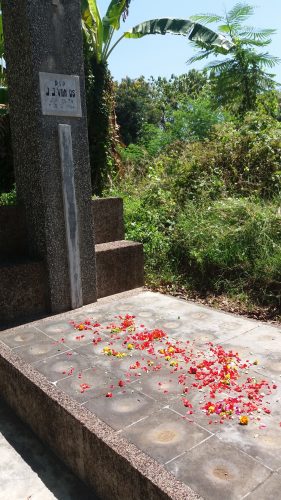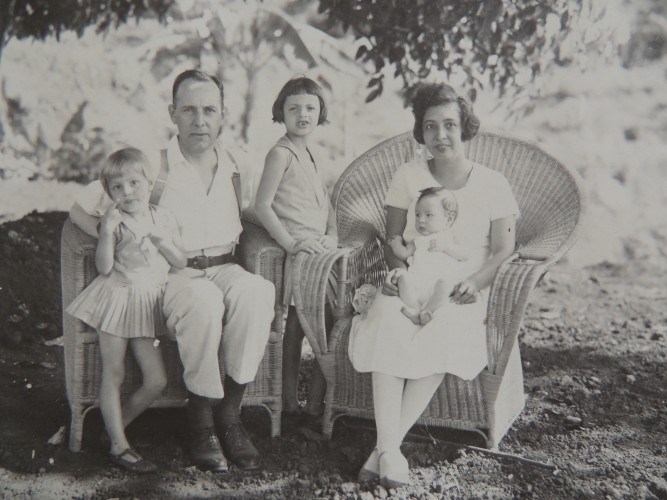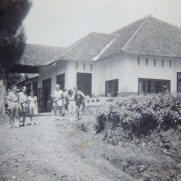- Graf J.J. van Os in Linggarjati
Three hundred years ago the lives of Indonesians and Dutch got intertwined. Our Dutch ancestors, often under very hard circumstances, crossed the oceans and settled down in different parts of a world unknown to them. They sailed to America, Japan, China, the West and the East and discovered the most beautiful country of the world: Indonesia.
In 1888, our grandfather Adriaan van Os and his wife left for the former Dutch Indies. He was a teacher. In Batavia (now Jakarta) they had three children. The youngest one, Koos van Os (Jacobus Johannes) was born on 26 October 1894. Around 1920 Koos van Os returned from the Netherlands – where he was educated – to the Dutch Indies, which he always considered his motherland. On 7 December 1923 he married Jane Elisabeth Leonie Dom, Lizzy, in Yokjakarta. Lizzy’s great-grandfather on father’s side, Jacobus Dom, was born in Antwerp on 12 June 1752. He arrived in the East as a colonial soldier with the ship ‘De Harmonie’ in 1773 and married Srima van Medono, born in Yogjakarta. Jacobus Dom died in 1810 in Yokjakarta and was buried on the old cemetery behind the market. Lizzy’s great-grandfather on mother’s side was a Portuguese named Pereira. This ancestor traveled to Macao (China) where he married a Chinese woman, and both of them finally landed in Surabaya. There, one of his sons (Lizzy’s grandfather) founded the first ice factory.
Koos van Os died on 22nd February 1934 in Linggadjati (now called Linggarjati) and was buried in Cheribon (now called Cirebon). He was only 39 years old.
As all papers and documents were lost during the Japanese occupation in World War II, much of what we know about my father was derived from a diary kept by Bob Bär (uncle of the in the Netherlands generally known Mgr. R.Ph. Bär), proxy holder of my father’s company Technisch Bureau J.J. van Os and the N.V. Algemene Industrieele Maatschappij (Algim), both in Cheribon.
From Bär’s diary I quote the following text about Cirebon: ‘Cheribon is an important residence in the Province of West-Java. This province has almost 2 million inhabitants (1931) of whom approximately 3.000 Europeans and 80.000 Chinese. The low lands in the northern part are known as one of the biggest rice areas of Java. It also has ten sugar factories and a big methylated spirit factory for processing treacle, a waste product of the sugar industry. The capital Cheribon (approximately 82.000 inhabitants of which 1.500 Europeans) houses among other things the big ‘Mestfabriek Java’ where several wagonloads of cattle bones from all over Java are delivered every day to be processed to bone meal. With phosphates from the mineral-rich southern mountains, this factory produces chemical manure for the entire archipelago. A disadvantage is the stench. The factory is situated at the seaside, but when the wind blows from the north, the stench spreads over large areas of the town. In the center of Cirebon town there is the powerful B.A.T. (British American Tobacco Company), the largest cigarette factory of the Dutch Indies.
Cheribon used to be an important seaport, mainly for the hinterland, the densely populated eastern Preanger, Tjiamis, Tasikmalaja, Garut. Cheribon is situated between the two main towns on Java’s northern coast, 250 km east of Batavia and 240 km west of Semarang. It has proper railway connections and roads in the four main directions.
The port itself, like all ports on Java’s north coast, suffers from silty deposits and sandbars and could only be reached by coasters. Large vessels have to anchor offshore, sheltered by the far protruding Cape Indramajoe, so high seas do not affect offloading. The Tagalsch Prauwenveer provides a large fleet of loading prawns (looking like Rhine barges) for the transport of shiploads to the port and custom sheds.’
A little bit further Bär describes his first acquaintance with Linggarjati: ‘The ‘daily’ arrived in Cheribon at 5 p.m., where I was collected by Koos van Os. We drove straight to Linggajati, a mountain village some 35 km over Cheribon on the slopes of the Tjeremai, a 3078 m high volcano. The journey took about 45 minutes. There I met Van Os’ family, his wife Lizzy and the two girls Cora and Joty [note of the author: at that time Wim hadn’t been born yet]. Van Os has bought a premises in Linggadjati consisting of a house built on piles with a beautiful view and a large yard. He changed this house into a brick building and extended it with some meters all around. As the family continued to live there, it could not be done at once. The extension is a great success.”







